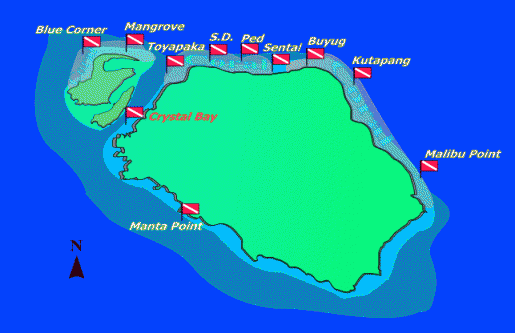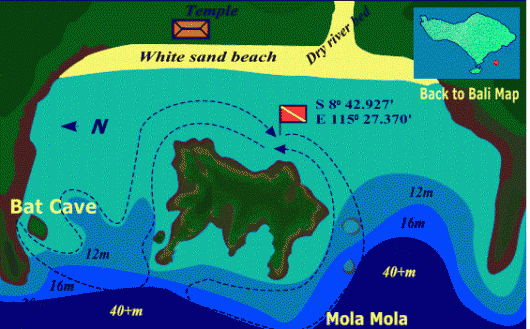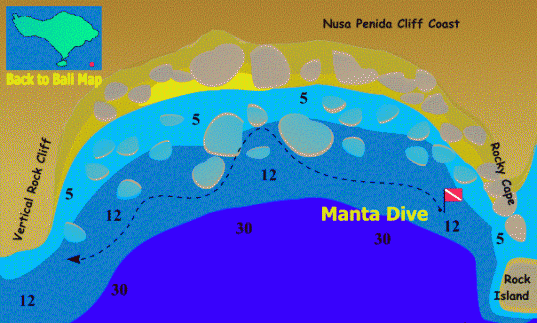Nusa Penida & Lembongan
It’s located across the Badung Strait from Bali’s Southern Tip, offers some of the best diving to be found anywhere. But conditions around Penida and its two sister islands-Nusa Lembongan and Nusa Ceningan- can sometimes be difficult, with unpredictable currents reaching four or more knots. This is not a place for beginner divers and inexperienced boatmen. Also, upwellings current from the deep water south of Bali, which keep the water crystal clear and makes the water uncomfortable cold. Due the currents sweeping past Penida means just about every single dive turns into a drift, it is worth bearing in mind the following points:
- Always stick close to the reef seek protection behind coral heads and bommies, and the currents flow right up against the reef is always less fierce.
- Overall, it is not most rewarding place for photography as its currents unpredictable shift and turn into strong, anyway as its water crystal clear, videographers will find these sites more satisfactory to their needs.
- Because of the strong currents unpredictable change in its intensity and course potential cause the diver easily separates from the group, recommended to bring an inflatable signal device, which it helps the skipper to see you when separated from group.
1. Toyapakeh
Toyapakeh is a small Muslim village on North Coast of the opening bay that separates Nusa Penida and Nusa Ceningan. Colonies of acropora coral dominates growing in shallow undergo down slope standing quite many porites boulders and coral heads, along the edged reef grows short corals and leather soft corals, which in this part frequently sweeps of the currents. A lot variety of reef fishes and even big pelagic fishes are abundance at this site. Around the end of June up to September, offers Sunfish cleaning station at the depth from 15 meters to 25 meters as the highlight of Toyapakeh and the water turns into cold roughly 20 C-24 C. Also, black jacks and turtles are frequently found here. The local dive operator sometimes called this place as- coral garden-. And if the current starts from southwest is best descending from the edge between Bay and the Channel and fins a long the edge to northeast under the jetty’s pillar, don’t go further as the swirl current is often occurred, exit and end up the dive is best option.
2. Sekolah Dasar ( SD )
Sekolah Dasar (SD) stands for an elementary school in local language. The reef offshore is named SD point by the local dive operators. This site stretch as long as the coastline offers a pristine healthy coral reef with swarm number of reef fishes mainly pelagic fishes, as the reef is extended stretching from east marked by the white fibre buoy to the most west marked by the jetty, which it separates from Toyapakeh. It is best to do a drift dive because the shore currents are always flowing with uniform direction miles away and the coral heads spread along the slope bottom and make us easy to stop or hide behind them. Reef shark, Sunfish (Mola-Mola) and even Manta Ray have frequently been seen. Experiencing a drift dive in Bali is best taking SD point at Nusa Penida.
3. Peed Point
Its name after the temple on the shore of the Peed village, apart from that on this beach was put the concrete wall to protect the beach from abruption. Descending right at the front of the wall in 5 meters water will lead toward the steep slope along the coastline, composition of the coral reef is mainly colonies stage horn coral, coral heads and bommies rich of marine fishes, even pelagic like Sunfish often visits this site. The reef is stretching east to west and both directions are interesting, best to begin the dive is up currents. The water temperature is unpredictable changing and can be dropped to 22 C whenever up current occurred.
4. Batu Nunggul
The capital city of Nusa Penida Island is called Batu Nunggul, offshore is there local harbour where the public boats are coming from Bali to embark the passengers and dock the boats. Further east of the main entrance of this a small bay is anchored the floating buoy to be used by the dive boats. The dive is begun, once descending to 5 meters water huge boulder rocks stretching stand on the steep slope bottom contour to deep blue water. To fin along the edge toward east, the reef pattern quite similar in its composition like boulder rocks, coral heads and bommies are extended until outcrop in a mile away from the entry point. Whenever the current flows downward is simply just to follow it and will end up in the wall continues to the slope rubble reef. Look close to the reef to see number of colourful nudibranch, tropical reef fishes and even pelagic like Manta Ray and Eagle Ray in the deep water. The current flow can be unpredictable changed to its intensity and direction, well coordination to the skipper must be done before the dive, so by the end of the dive the skipper does not make a mistake in providing pickup services. The water temperature can be 26 C or even lower whenever up current occurs.
5. Crystal Bay
It refers to its name Crystal Bay is actually situated in the bay of Penida Village, which it widely opens into Ceningan Channel between Nusa Penida and Nusa Ceningan (the smallest island amongst 3 sister islands). Inside the bay is anchored permanent floating buoy that used to anchor the diving boats, and right in the middle of the bay stands the huge lime rocks on the edged of the channel as to mark of this diving site. From the place where the anchor is, the plated sand bottom with some bommies well covered by soft corals, keep swimming on the right side (north) from a huge single lime rock toward the channel will end up in a wonderful cave underwater in 11 meters water leads up to the surface under rugged lime cliff, suddenly will be heard the voice of abandon of bats clinking on the sealing of the cave. It is absolutely amazing being inside it where the sun light goes through between the cracked rocks to make even more beautiful scene. Sometimes single White Reef Tip Shark mostly baby one hides in the cave. After few minutes surfacing then descending again out to the channel might swim against the current otherwise it puts into deep water as the result of the current from the channel and the current out from the bay. Keep the coral reef on left hand side as you swimming along the slope, and keep looking toward the deep may big pelagic fishes do cleaning in the edged of overhang in 25 meters. The coral reef grows short and bit of rubble as the current frequently strong, make sure to swim close against the bottom, as you go along the edged then end up rightly in the corner that leads to the bay, at this place there are two cleaning stations for The Sunfish, in 18 meters and in 30 meters or more meters on the sand bed toward the bay. These fishes are quite friendly and the most calmest creatures, but they afraid with the bubbles of divers and best to get close to them by approaching from the tail (actually is no tail but body extension) or well control the breathing which is resulting a very small bubbles. The highlighted of this site beside the cave also the Sunfish cleaning stations and are best to discover them from the left of the huge lime rocks offshore, lead directly into the cleaning stations. Anyway the Sunfish appearances are depending on the season, July to September. Good luck to see them and remember well prepared of exposure suits due of cold water temperature…ha..!
6. Gamet Bay
This is actually a small bay located between the Crystal bay and Toya Pakeh, its open directly to the channel of Nusa Penida. Boat divers are anchored in the bay where the diving is begun, the bottom well covers with soft corals, once move out to the channel about 12 to 14 meters water bush of Stagehorn Corals healthy growth continue to the steep slope of the channel. To dive in this site needs to check water condition, when the waves lapse the bay then the diving is nearly impossible due the water stirs up and strong current occurred in the channel. Plat water in the bay and doesn’t notice the swell from surface is the favourable condition to dive. Great number of fishes like big pelagic, coral reef fishes and many more are common here. A long the steep slope of the channel is interesting colourful reef to dive but just be careful as the current in the channel is unpredictable changing its strength and direction. Visibility is roughly excellence, water temperature is little cold. Prepared suitable exposure suit is very important to keep the body warm. Let’s get wet ….yach!
7. Manta Point
The name of this dive site is derived from the Giant Manta Ray patrols around it, often found by the divers and almost all the year around. To get this site is a must to cruise 50 minutes longer compared to go to other sites in Nusa Penida. Its location is the most south of the island, potential hazardous is big surges which could affect the technique of entry procedure, sometime starts from deep water. The maximum deep would be 15 meters, mostly stay in 4 to 6 meters where Manta Rays patrol along the line of the cliff, no further deeper than 15 meters. The bottom composition is huge boulder rocks are stretching along the edge of the cliff, further left pace to the cliff do not exceeding the ragged wall, where the current picks out up to the deep beside there will be no Manta Rays as well. And to right will continue slope bottom, the current gets stronger between two huge boulder rocks headed out on the surface. The best place to see Manta Rays are at the left corner about 5 meters beside the huge boulder rock, stay calmly then Manta Rays will get closer and closer to swim around in small school of 3 to 6 Manta Rays. How is happened if chasing them, they will swim like a fly…believe or not that you may try it, are you ready?
8. Blue Corner, Lembongan
This dive site is real adventure dive, suits only for Experienced Divers, where the current is unpredictable changing its strength and direction. The bottom composition is short polished corals due to strong current flows down slope until to the overhang in 25 meters, winds to deeper water. If suddenly is caught by massive current safely hiding in the overhang, wait there while to view the variety of school fishes like Marble Sting Rays, Sweetlipfishes, Tunas and many other creatures which they stay against the current for prey. Afterward start to move away scrolling along the bottom towards shallow water if the air in the tank shows 75 bar minimum until to find the ideal place to do safety stop. The water temperature roughly cold as the thermocline occurs quite often, it can reach 20 C, well prepared to dive at this point is a must like BCD, Regulator and Wet Suit. The adrenaline will rise up faster than anywhere dive sites ever, maybe…!
9. Sakenan, Lembongan
This dive site names after the temple on the shore of Lembongan, offers extending coral reef. Current flows along the shore, is best to do drift diving. Variety of corals growth but mainly stagehorn coral bushes in 5 to 10 meters where live abandon of coral reef fishes, and downward to the deep dominates with the hard massive corals or dome corals grow rather short due to frequently strong current occur. To end up the dive and easily to mark is better to bring surface float or sausage floatation so the skipper easily to see from the surface in providing service. The water temperature roughly warm 28 C to 30 C and sometime even drops below if thermocline occurred. It always experiences good visibility to dive at this site.
10. Jangkar Point, Lembongan
It located just north east tip of main Lembongan Island, offers quite nice a short wall with variety of coral reef fishes. This wall reef splits up the current pouring from SD point and the channel of Nusa Penida Island, these will affect the diver does the diving at this point because it’s potential of down swirl current with the massive power. The best time to dive is when mild current and from the surface doesn’t notice white top wave with the swirling. Well, the water temperature is about the average 28 C and can be dropped below depends on the season and thermocline occurs.
11. Malibu Point
The reef at this point isn’t different than the dive sites on the north shore of Nusa Penida, gradual slope reef to 18 meters then sharper slope to deeper water. The reef grows short with many Sea Whips spreading along the slope and its length can be over 2 meters, these are the indication of the current sweeps frequently from mild to moderate one. The diving is descended from down current until to the corner of the most eastern tip of the Island, once close to the corner, current shifts toward open sea. The sea creatures have been reported to see are Reef Sharks, Manta Rays and other big pelagic, surely variety of tropical reef fishes. To get this point will take another hour cruise from common Nusa Penida points like SD or Peed. Water temperature is about average 28 C, and a courageous safety is recommended to float up the sausage to be used by the skipper to get you after the dive.
12. Tugu Point
Tugu is ‘a small shrine’ in Balinese word and its function to be used to pray The God as Guardian of the Balinese property like ocean, houses etc. Tugu on this site is just about the water line lapses the shore. Descending is begun from the front of Tugu to the slope a long the coastline depends on the current direction, offers colourful reef with some boulder rocks headed and tropical reef fishes are swimming around. Many divers have also reported to spot ‘Sunfish’ in the steep slope where is suited for cleaning station of this creature, Banner Fish does clean it. Water clarity is average up to 15 meters distance, temperature is warm likes bathing water. If supposes to dive toward the small village’s harbour is better to end up the dive before it regarding the safety of the group, the local skippers are not familiar with the diver rule of thump.
13. Karang sari
Dive site of Karang Sari is in a small bay, because of its location the water relatively calm in condition and best to take novice divers or training dive. The contour of the site is slope reef to10 meters then the overhang falls to 20 meters to sand slope bottom. The colourful of variety of soft corals are well covered the reef and the variety of tropical fishes like Anthias, Banner, Parrotfish and others are abandon. The clarity of the water is crystal clear and average temperature under water is roughly warm 29 C.
14. Ceningan Wall
Ceningan Island is one of the smallest out of three sister islands of Nusa Penida, it offers a sheer wall dive with the healthiest reef, soft corals and table corals are well grown into Nusa Penida channel. To carry the dive activity at this point is a must to pick up the slack high tide where the water condition is full and calmness contrary will unable and unsafe to dive at it. Several of pelagic types are common countered a long the wall and their sizes are rather bigger compared are found in the other location around the Island. The diving boat will then is anchored at the north tip of Ceningan Island from where group of divers descend to discover the wall and exit out down current in the channel. As the current is changeable its strengths and direction, to apply safety first is judgement as a crucial action to be taken by diver as personal or leader of the group. The water temperature is roughly cold as much as 25 C, sometime even lower as water from the deep rises up to the surface, well prepared of exposure suit is a must to be able to keep the body warm.




